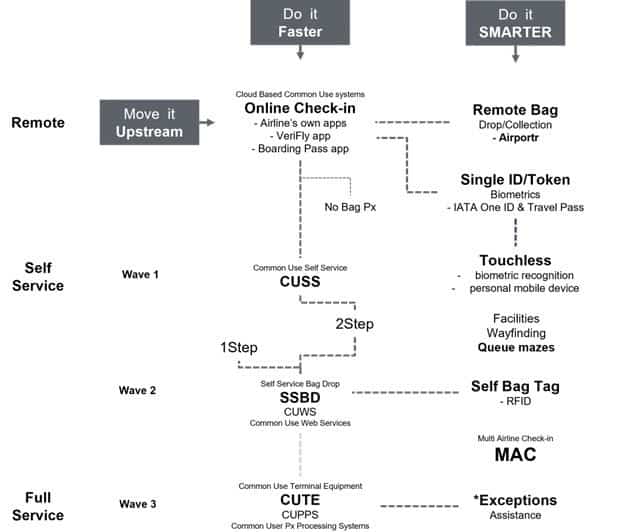
In our third and final blog in our series on airport automation we discuss the ways in which airports and airlines can make use of smarter new technology solutions. As referenced in our previous blogs Star Alliance has defined an approach to newer technology solutions that are now being introduced, shown in the graphic below, which focuses on:
Move it upstream
Do it faster
Do it smarter
We discussed ‘Move it upstream’ in our first blog, moved on to ‘Do it faster’ in our second blog and in the final blog of the series we cover ‘Do it smarter’.

Remote Bag drop/collection
Dropping the bag off at the airport can be inconvenient and can result in queuing. A remote collection service such as AirPortr is working with airlines such as British Airways, American Airlines, easyJet etc and collects the bag from the passenger, either from home or their place of work, and then drops the bag off at the departure airport. The bag is screened off airport and is then taken into the airport through the security control posts and put into the baggage system for full screening. Currently, the bag still has to fly with the passenger but in the future it may fly cargo to be picked up at the arrivals’ airport reclaim or could even be part of a completely remote process where it is taken straight to the hotel.
This obviously takes the check-in process off the airport, freeing up capacity.
Self Bag Tag
As a frequent flyer having a personalised bag tag registered to the individual means the need to print a bag tag for every flight (which currently can only be done at the airport) is avoided. The bag can be registered before arriving at the airport leaving just the one-step process of placing the bag into the baggage system. There are some technologies which have an RF transmitter in the tag allowing the bag to be located during transit.
Learn more about BAGTAG here or TAG from British Airways here.
Single ID/Token
This is a biometric identity system carried with the passenger with the passport biometrics and all other details and documentation needed to fly.
IATA have developed One ID Travel Pass which you can find out more about here.
There is currently a potential data protection issue with this kind of system and the sharing of personal data across different organisations such as airport, airline, border agencies, etc. The individual will need to provide permission at each point of use to comply with data protection laws which do not allow the transfer of personal information between different entities.
Touchless
There are two forms of Touchless:
- Mobile – instead of touching the CUSS or SSBD kiosk the data is held on your smart phone and is scanned at the kiosk
- Biometric – the next level is where all transactions are done at home, put online and facial or fingerprint recognition is used to recognise the passenger and enable the transaction.
Exceptions
Dealing with the list of check-in exceptions is still mostly manual as of the last quarter of 2022 but some automation is extending to documentation such as COVID vaccination certificates. Apps like VeriFLY are coming on stream to automate this transaction as well as the airlines’ own apps. Exceptions can also include visas, work visas, Electronic System for Travel Authorization to the USA, etc.
Other exceptions such as firearms and out of gauge luggage are not automated at all yet; airports and airlines need to get smarter in order to speed the exceptions process up and find cleverer ways to manage them using automation.
Facilities, Wayfinding and queue mazes
Making it smarter also includes better filtering as you enter the terminal. For example, a passenger with a family and out of gauge luggage for a skiing holiday may be directed to a full-service desk while a business traveller with cabin baggage is directed to a SSBD kiosk. Currently this is done by a member of staff at the airport but in the future your smart phone will be able to direct you automatically by knowing whether a ‘complex’ or ‘non complex’ check-in is needed. While some manual processes are still required, airports and airlines can still better automate the sortation process and become smarter at managing exceptions and providing assistance. The airport of the future will have most of the check-in processes automated leading to improved passenger flow and less need for queues and queue mazes. Simplify the process, reduce the transaction time and create infinite capacity.
MAC
Multi airline check-in allows any airline check-in at any check-in point. This is enabled by the technologies discussed in our previous blogs. Constrained airports and hub airports are in the early phases of adoption of MAC technology.
Our experience at AiQ shows that its implementation needs a high level of co-operation between the airlines, the handlers and the airport and a high level of automation.
At AiQ, our award-winning team of operational and analytical experts are dedicated to analysing, modelling and optimising every aspect of an airport. If you would like to find out more about automated technology and how it could benefit your airport please do get in touch.
You can read the first blog in our Airport Automation series here.
You can read the second blog in our Airport Automation series here.

